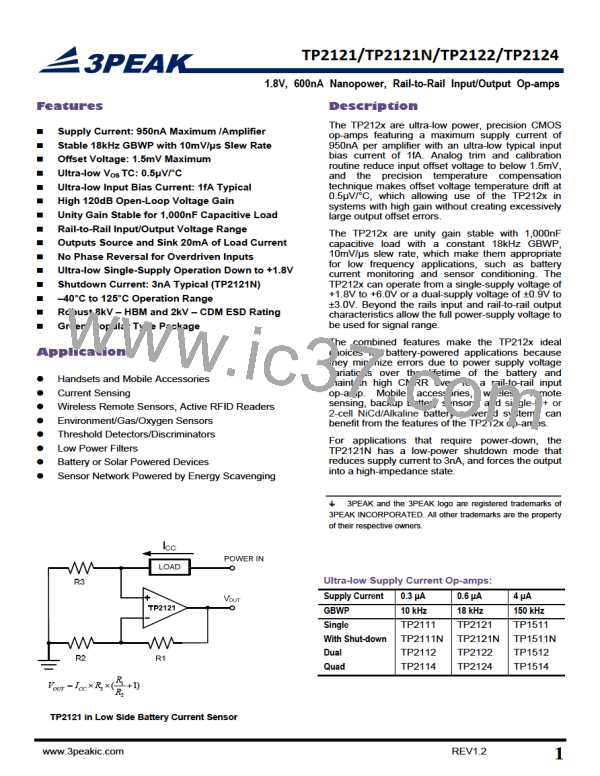TP2121/TP2121N/TP2122/TP2124
1.8V, 600nA Nanopower, Rail-to-Rail Input/Output Op-amps
Matching components should be located in close proximity and should be oriented in the same manner. Ensure leads
are of equal length so that thermal conduction is in equilibrium. Keep heat sources on the PCB as far away from
amplifier input circuitry as is practical.
The use of a ground plane is highly recommended. A ground plane reduces EMI noise and also helps to maintain a
constant temperature across the circuit board.
BATTERY CURRENT SENSING
The Common Mode Input voltage Range of TP212x OPA series, which goes 0.3V beyond both supply rails, supports
their use in high-side and low-side battery current sensing applications. The low quiescent current (600nA, typical)
helps prolong battery life, and the rail-to-rail output supports detection of low currents.
The battery current (IDD) through the 10Ω resistor causes its top terminal to be more negative than the bottom terminal.
This keeps the Common Mode Input voltage below VDD, which is within its allowed range. The output of the OPA will
also be blow VDD, within its Maximum Output Voltage Swing specification.
VDD VOUT
IDD
R1
R3
R2
Figure 3
Instrumentation Amplifier
The TP212x OPA series is well suited for conditioning sensor signals in battery-powered applications. Figure 4 shows
a two op-amp instrumentation amplifier, using the TP212x OPA.
The circuit works well for applications requiring rejection of Common Mode noise at higher gains. The reference
voltage (VREF) is supplied by a low-impedance source. In single voltage supply applications, VREF is typically VDD/2.
R
2R
1 ) VREF
R2 RG
1
VOUT =(V V2 )(1
1
Figure 4
Buffered Chemical Sensor (pH) Probe
The TP212x OPA has input bias current in the pA range. This is ideal in buffering high impedance chemical sensors
such as pH probe. As an example, the circuit in Figure 5 eliminates expansive low-leakage cables that that is
required to connect pH probe to metering ICs such as ADC, AFE and/or MCU. A TP212x OPA and a lithium battery
are housed in the probe assembly. A conventional low-cost coaxial cable can be used to carry OPA’s output signal to
subsequent ICs for pH reading.
www.3peakic.com
REV1.2
11

 3PEAK [ 3PEAK ]
3PEAK [ 3PEAK ]